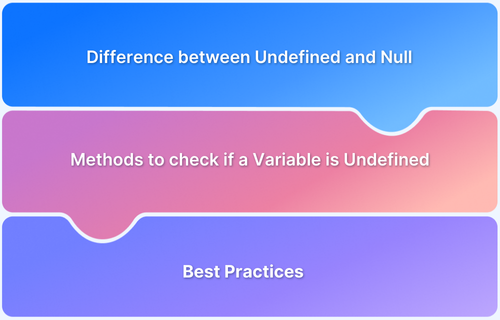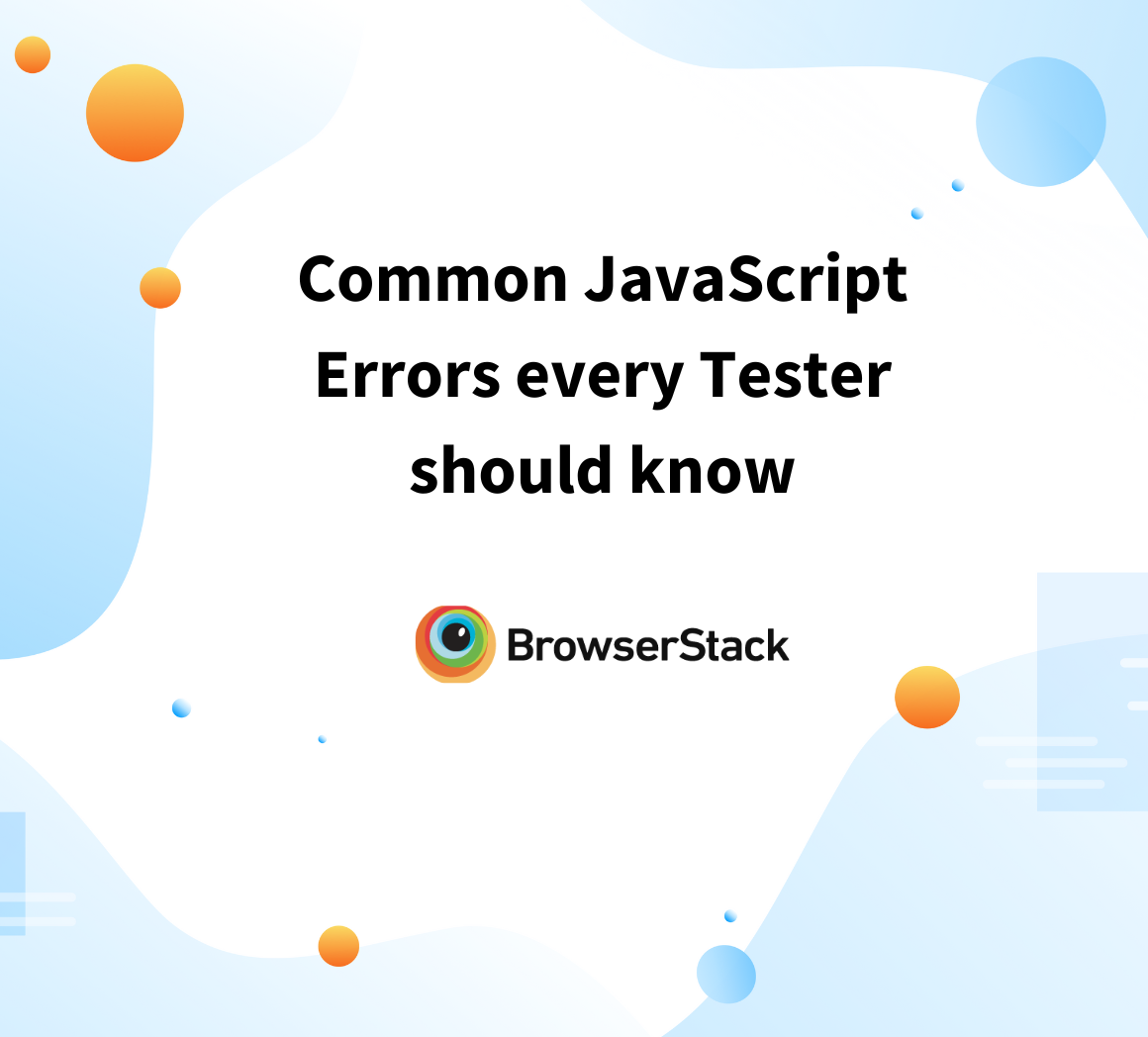In JavaScript, variables play a fundamental role in storing and manipulating data. But knowing whether a variable is defined or undefined is key to writing reliable, error-free code. When a variable is declared but not assigned a value, it automatically holds the value undefined.
Overview
Why identify if a Variable is Undefined?
Understanding how to identify undefined variables is especially important when working with dynamic data. It helps avoid runtime errors and unexpected behavior in your applications.
Difference Between undefined and null in JavaScript
In JavaScript, undefined is the default value for variables that have been declared but not initialized. On the other hand, null is an intentional assignment that explicitly indicates the absence of a value.
Methods to Check if a Variable is Undefined
- Using typeof Operator
- Using Strict Equality (===)
- Using Loose Equality (==)
- Using the void Operator
- Using a Custom Utility Function
This article covers different ways to check if a variable is undefined, helping you write code that handles these situations smoothly. it walks through practical examples and best practices for handling undefined variables effectively.
Understanding Undefined Variables in JavaScript
In JavaScript, the value undefined is a primitive data type and represents a variable that has been declared but not yet assigned a value. It is the default value for variables that are declared but not initialized. For example, if a variable is created without an assignment, it will automatically hold the value undefined. Have a look at the example below :
let x; console.log(x); // undefined
In the example above, the variable x is declared but not assigned any value, so it is considered undefined.
Difference between Undefined and Null in JavaScript
Though both undefined and null represent “no value,” they are distinct types in JavaScript.
- undefined: This is the default value of uninitialized variables. It is automatically assigned when a variable is declared without a value. It is also the return value of a function that does not explicitly return anything.
- null: This is an explicit assignment that indicates a variable is intentionally empty. It is a primitive type, but due to an old JavaScript bug, typeof null returns “object”. null is often used to signify that a variable should be assigned a value later.
Look at the example below :
let a; // undefined let b = null; // null console.log(a); // undefined console.log(b); // null console.log(typeof a); // "undefined" console.log(typeof b); // "object" (historical quirk)
Now, In this example:
- a is undefined because it hasn’t been assigned a value.
- b is explicitly set to null to indicate the absence of a value.
For more clarity, have a look at the key differences in the tabular form below:
| Feature | undefined | null |
|---|---|---|
| Type | Primitive type (undefined) | Primitive type (null) |
| Assigned Automatically? | Yes, for uninitialized variables | No, needs to be explicitly assigned |
| Usage | Default value for variables not initialized, return value of functions with no return statement | Explicitly assigned to indicate “no value” or “empty” |
| typeof Output | “undefined” | “object” (historical quirk) |
| Common Usage | Variables, function return values, missing object properties | To represent a variable that is intentionally empty |
| Example | let a; console.log(a); // undefined | let b = null; console.log(b); // null |
undefined and null are both used to represent the absence of a value in JavaScript, but they serve different purposes, undefined is the default state of variables that have been declared but not initialized, and null is an intentional assignment that indicates the variable is empty. It’s important to remember the typeof null quirk for consistency across your code and understanding.
Common Scenarios for Undefined Variables
There are several scenarios in JavaScript where a variable may be undefined. A few frequent scenarios include :
1. Uninitialized Variables
A variable that is declared but not assigned a value will automatically have the value undefined. Below is the sample code
let name; console.log(name); // undefined
2. Function Parameters Not Provided
If a function is called without supplying arguments for all of its parameters, the missing parameters will be undefined. Here is a demonstration of the code:
function greet(name) {
console.log(name);
}
greet(); // undefined3. Accessing Non-Existing Object Properties
If you attempt to access a property that doesn’t exist on an object, it will return undefined. This is an example of the code.
const person = { name: "John" };
console.log(person.age); // undefined4. Array Indices
If you try to access an element of an array that hasn’t been initialized, it returns undefined. Here’s an example of the code.
let numbers = [1, 2]; console.log(numbers[3]); // undefined
Read More: Common JavaScript Issues and its Solutions
Methods to check if a Variable is Undefined
In JavaScript, there are various methods available to check if a variable is undefined. Each method has its own use cases and subtle differences.
1. Using typeof Operator
The typeof operator can be used to check if a variable is undefined by comparing its type with the string ‘undefined’. Here is an example of the code.
let a; console.log(typeof a === 'undefined'); // true
This method is safe because it won’t throw an error if the variable is undeclared.
2. Using Strict Equality (===)
Strict equality (===) can also be used to check if a variable is strictly equal to undefined. However, the variable must already be declared. Below is the sample code:
let b = undefined; console.log(b === undefined); // true
This method will throw a ReferenceError if the variable is undeclared.
3. Using Loose Equality (==)
Loose equality (==) compares values and allows type conversion. Since undefined is loosely equal to null, this method can produce unexpected results.For example:
let c; console.log(c == undefined); // true
Loose equality can be less precise than strict equality because it also returns true for null.
4. Using the void Operator
The void operator evaluates an expression and returns undefined. It is typically used to explicitly return undefined from a function. Look at the example below :
let d = void 0; console.log(d); // undefined
This is often used when it’s important to ensure a variable is explicitly assigned undefined.
5. Using a Custom Utility Function
You can create a custom utility function to check for undefined and handle more complex conditions or specific use cases. Code example as follows:
function isUndefined(value) {
return value === undefined;
}
let e;
console.log(isUndefined(e)); // trueThis function can be extended to handle additional edge cases as needed.
Essential things to consider :
- undefined vs. null: Remember that undefined and null are two distinct values. undefined typically represents an uninitialized variable, while null is an intentional absence of a value.
- When working with undefined, it’s often a good idea to use strict equality (===) checks to avoid unexpected behavior.
Best Practices for using Undefined Variables in JavaScript
Proper handling of undefined variables is crucial for writing robust, error-free JavaScript code. Below are some best practices to follow:
Best Practices for Using Undefined Variables in JavaScript:
- Always Initialize Variables
- Use Default Parameters in Functions
- Check for Undefined Values Before Accessing Properties
- Use typeof for Safe Checks
- Avoid Assigning undefined Explicitly
- Leverage Optional Chaining
Here is a detailed explanation of each best practice:
1. Always Initialize Variables
To avoid unintentionally working with undefined values, always initialize variables at the time of declaration. This reduces ambiguity and potential bugs in your code. Below is the code example:
let count = 0; // Initialize with a default value
2. Use Default Parameters in Functions
When defining functions, use default parameters to handle cases where arguments are not provided. This prevents the parameters from being undefined. Look at the code example below:
function greet(name = "Guest") {
console.log(`Hello, ${name}!`);
}
greet(); // Output: Hello, Guest!3. Check for Undefined Values Before Accessing Properties
When working with objects, it’s important to check if a property exists before accessing it. This avoids runtime errors or unexpected undefined values. For example :
const person = { name: "John" };
if (person.age === undefined) {
console.log("Age is not defined");
}4. Use typeof for Safe Checks
Prefer using the typeof operator to check if a variable is undefined, especially when the variable may be undeclared. This method is safe because it won’t throw an error if the variable is undeclared. Following is the sample code:
if (typeof someVariable === "undefined") {
console.log("Variable is undefined");
}5. Avoid Assigning undefined Explicitly
It’s generally better to use null to indicate the intentional absence of a value. Reserve undefined for uninitialized variables or for default behavior when no value is provided. Below is an example:
let value = null; // Indicates intentional absence of a value
6. Leverage Optional Chaining
When accessing deeply nested properties, use optional chaining (?.) to safely handle undefined values and avoid runtime errors. Here is the code example:
const data = { user: { profile: null } };
console.log(data.user?.profile?.name); // undefinedBy following these best practices, you can minimize bugs and write more maintainable, predictable JavaScript code.
Critical reminders:
- null vs. undefined: Remember, null is explicitly used to represent “no value” or “intentional absence,” while undefined is typically used for variables or properties that haven’t been initialized.
- Optional Chaining: Optional chaining is particularly useful when working with APIs or complex data structures, as it prevents errors from accessing properties on null or undefined objects.
Why choose BrowserStack to execute JavaScript Tests?
When it comes to testing JavaScript code across different browsers and devices, BrowserStack Automate is a solid choice. Here’s why:
- Effortless Cross Browser Testing: BrowserStack gives you access to thousands of real browsers and devices, making sure your JavaScript tests work smoothly on a variety of environments.
- Cloud Based Testing Made Simple: Skip the headache of managing your own testing infrastructure. With BrowserStack, you can run tests instantly on real devices, all from the cloud.
- Parallel Testing to Save Time: BrowserStack allows you to run multiple tests at the same time, which significantly reduces execution time and helps speed up your development process.
- Easy Debugging: Quickly identify and fix issues with tools like live logs, screenshots, and video recordings of your test runs, making debugging a breeze.
- Seamless Integration: BrowserStack integrates easily with popular test automation frameworks and CI/CD tools, so adding JavaScript tests to your existing workflow is quick and easy.
By using BrowserStack Automate, you can make sure your JavaScript code performs well across all browsers and devices, saving time and ensuring high-quality results.
Conclusion
Checking for undefined variables is a fundamental aspect of JavaScript programming. This article explored the concept of undefined, common scenarios where it occurs, and the best practices to handle it effectively. Additionally, we discussed methods to verify if a variable is undefined and why BrowserStack Automate is an excellent choice for executing JavaScript tests.
Incorporating robust testing practices and tools like BrowserStack can help developers ensure their JavaScript code is error-free and performs well in real-world scenarios.





